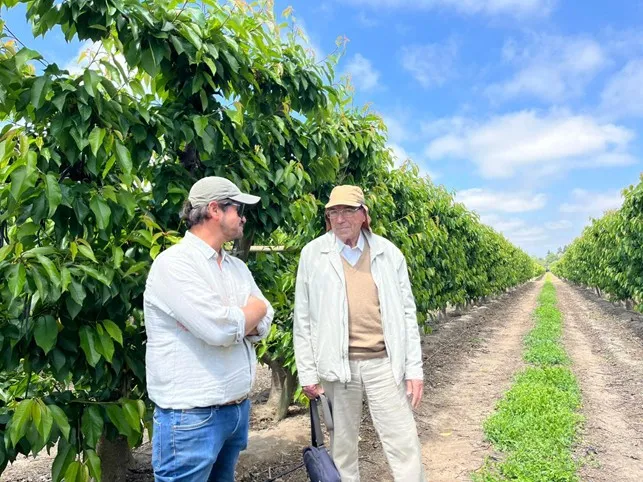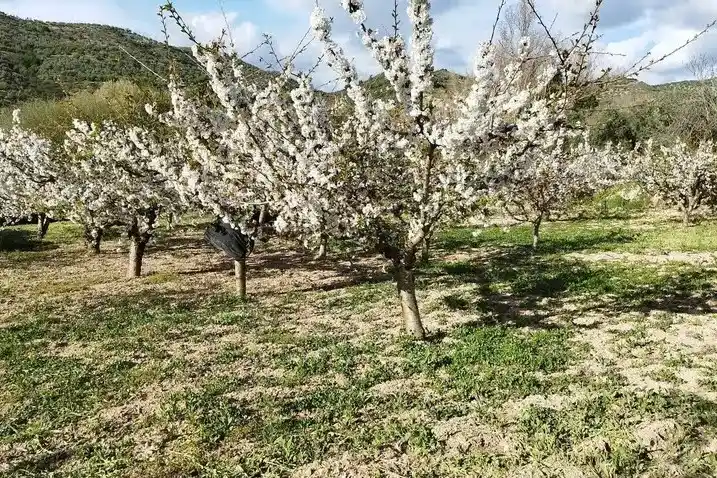Postharvest application of elicitors to maintain the quality of Regina cherries
To address internal browning in this variety, postharvest immersion treatments with growth regulators and elicitors such as oxalic acid (OA), salicylic acid (SA), methyl jasmonate (MeJA), and abscisic acid (ABA) were studied.
The 2024/25 season was not without challenges. Between January 1 and 11, 2025, there was a price drop ranging from 30% to 60% compared to the same period the previous year, mainly due to an oversupply of cherries in China and low fruit quality upon arrival (Bravo, 2025; SNA, 2025).
However, from January 12 onward, prices recovered (Bravo, 2025). This trend is being studied as it will pose new challenges and require further analysis for the Chilean cherry industry.
Quality control and market preferences
On the other hand, the Chinese market places high value on cherries with a bright, dark red color, making external color at harvest a key factor for ripeness control.
Firmness and flavor also play a decisive role in consumer acceptance: overripe, soft fruits or those with visual defects like pitting or leathery skin tend to lose commercial value, especially after prolonged storage.
To maintain fruit quality throughout the long export process, which can last over a month, proper postharvest storage is essential.
This requires strict temperature control, ideally at 0°C, and high relative humidity between 90% and 95%, to prevent dehydration and preserve fruit freshness.
Modified atmosphere and exported varieties
Modified atmosphere techniques are also used, reducing oxygen (O₂) and increasing carbon dioxide (CO₂) levels in the packaging, thereby slowing down fruit metabolism and extending shelf life.
The main exported varieties include Santina, Lapins, and Regina. The latter is particularly prone to internal flesh browning, a disorder that worsens during storage and significantly reduces commercial value (Fuentes et al., 2023).
To address this issue, postharvest immersion treatments with growth regulators and elicitors such as oxalic acid (OA), salicylic acid (SA), methyl jasmonate (MeJA), and abscisic acid (ABA) were studied.
These compounds are believed to extend cherry shelf life and reduce internal browning by activating natural defense mechanisms (Alcantara et al., 2019).
Outlook for the cherry industry
In addition to preserving quality, these treatments are environmentally friendly and safe for human health, enhancing the competitiveness of Chilean cherries in demanding markets like China.
The combination of proper postharvest practices and the use of regulators and elicitors thus appears to be a key strategy to maintain and strengthen Chile's position as a world leader in cherry exports (Riverón, 2024).
Handling and storage
The fruit was processed, sorted by ripeness stage, and packed at the exporting company GEOFRUT. It was then sent to the Postharvest Studies Center (CEPOC) at the Faculty of Agricultural Sciences, University of Chile, where day-0 (harvest) analyses were carried out to initially characterize the fruit by maturity stage.
The experiment included 18 treatments combining the factors of maturity stage (MS), elicitor (E), and concentration (C). A control treatment was included for each maturity stage (Table 1), involving immersion in potable water without elicitor.
Each experimental unit consisted of a 500 g clamshell of fruit, with 3 replicates per treatment. For immersion, about 1.5 kg of cherries were placed in mesh bags and dipped for 1 minute in 40 liters of solution, according to the assigned treatment.
Each solution was prepared using 5°C potable water, to which 20 mL (5 mL per 10 L) of Break surfactant (BASF, Chile S.A.) was added to enhance elicitor application. The fruit was then dried on absorbent paper trays for 2 minutes, placed in 500 g clamshells, and sealed in low-density polyethylene (LDPE) bags to generate a modified atmosphere (MA).
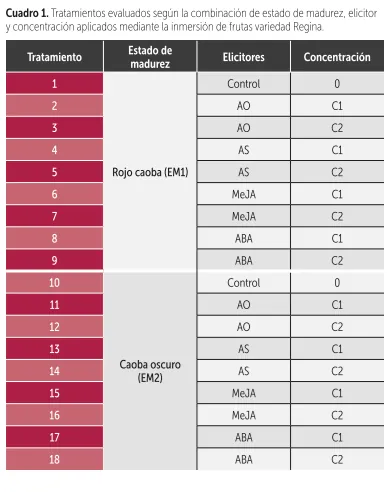 Table 1. Treatments assessed based on the combination of maturity stage, elicitor, and concentration applied through fruit immersion in Regina cherries.
Table 1. Treatments assessed based on the combination of maturity stage, elicitor, and concentration applied through fruit immersion in Regina cherries.
Experimental conditions
All treatments were stored in a cold chamber at 0°C, and evaluations were carried out after 35 and 42 days, followed by a simulated 3-day marketing period at 10°C.
Factor nomenclature is as follows:
- Maturity stage → MS1: mahogany red; MS2: dark mahogany
- Elicitors → OA: oxalic acid; SA: salicylic acid; MeJA: methyl jasmonate; ABA: abscisic acid
- Concentration →
- C0: water control
- C1: 0.5 mM for OA, SA, and MeJA; 50 ppm (0.1892 mM) for ABA
- C2: 1 mM for OA, SA, and MeJA; 100 ppm (0.3784 mM) for ABA
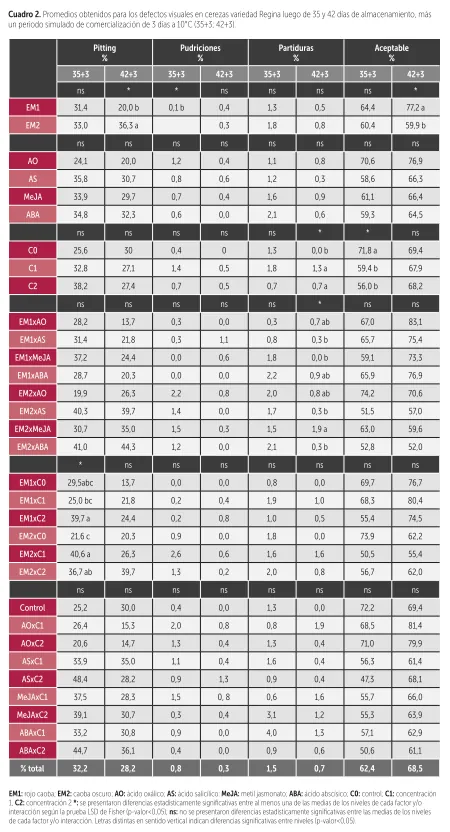 Table 2. Means for visual defects in Regina cherries after 35 and 42 days of storage, plus a 3-day simulated marketing period at 10°C (35+3; 42+3). Legend (below table): MS1: mahogany red MS2: dark mahogany OA: oxalic acid SA: salicylic acid MeJA: methyl jasmonate ABA: abscisic acid C0: control C1: concentration 1 C2: concentration 2 ns: not significant. Different letters in the same column indicate statistically significant differences between means of the same factor level or interaction, based on Fisher’s LSD test (p < 0.05). “ns” indicates no significant differences between factor or interaction levels.
Table 2. Means for visual defects in Regina cherries after 35 and 42 days of storage, plus a 3-day simulated marketing period at 10°C (35+3; 42+3). Legend (below table): MS1: mahogany red MS2: dark mahogany OA: oxalic acid SA: salicylic acid MeJA: methyl jasmonate ABA: abscisic acid C0: control C1: concentration 1 C2: concentration 2 ns: not significant. Different letters in the same column indicate statistically significant differences between means of the same factor level or interaction, based on Fisher’s LSD test (p < 0.05). “ns” indicates no significant differences between factor or interaction levels.
RESULTS
Initial evaluation
Overall, fruits had good initial quality, with minimal defects and no significant differences between the two maturity stages. Firmness measured by durometer was 4% higher in MS1 compared to MS2, with values of 86 and 82 Ush, respectively.
The FirmPro device showed an average of 335 gf mm⁻¹, with no significant differences. Soluble solids content (SSC) was 19.2% for MS1 and 20.2% for MS2. Titratable acidity (TA) was 0.65%, and the SSC/TA ratio was 30.4, again with no differences between maturity stages.
Gas concentration
Gas concentrations inside the modified atmosphere bags remained stable throughout storage at 0°C, with 18–19% O₂ and 2–3% CO₂.
Weight loss
The evaluated factors acted independently, with no significant differences between levels. Average weight loss was 0.66% after 35 days at 0°C + 3 days at 10°C, and 0.68% after 42 days at 0°C + 3 days at 10°C.
Condition
After 35 days at 0°C followed by 3 days at 10°C, a significant interaction was found between maturity stage and concentration for moderate to severe pitting.
The MS1×C2 combination had the highest defect level, with over 18% more incidence compared to MS2×C0, which had the lowest. All treatments had less than 2% of fruits with decay or cracking.
Acceptable fruit percentage
After 35 days at 0°C + 3 days at 10°C, significant differences were observed for the concentration factor: fruits treated with C1 and C2 had on average 10% fewer acceptable fruits (without defects) compared to the control.
After 42 days at 0°C + 3 days at 10°C, MS2 fruits showed 16% higher pitting incidence (moderate to severe) and 17% fewer fruits in good condition compared to MS1 fruits (Table 2).
EVALUATIONS
Gas concentration
Gas concentrations inside the bags were measured every 7 days using a portable analyzer. Measurements were taken at three time points: fruit arrival at the lab (start of storage), after 35 days at 0°C + 3 days at 10°C, and after 42 days at 0°C + 3 days at 10°C. Each evaluation involved 3 replicates per treatment.
Physical parameters
Weight loss was calculated as the difference over time. Fruit condition was assessed based on the presence of pitting (moderate to severe), decay, cracking, and acceptable fruit. Firmness was measured by compression using the FirmPro device (gf mm⁻¹) and a Baxlo durometer (Shore units, Ush).
Internal browning (IB) was classified by the percentage of affected flesh, using three levels:
1 = <20%; 2 = 20–50%; 3 = >50%.
Chemical parameters
On juice extracted from 10 fruits per treatment, soluble solids content (SSC) was measured using a digital refractometer (ATC-1E 0–32%, Atago, Japan). The same juice was used for titration to determine titratable acidity (TA), expressed as a percentage of malic acid, and the SSC/TA ratio was calculated.
Statistical analysis
A completely randomized design with a factorial structure was used, considering the following factors:
maturity stage (2 levels),
elicitor (4 levels),
concentration (3 levels).
The data were analyzed using linear mixed models; in the case of significant interactions between factors, Fisher’s Protected Least Significant Difference (LSD) Test was applied (α<0.05).
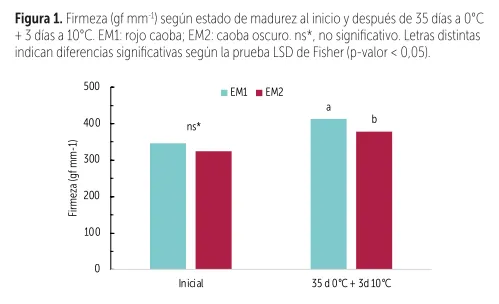 Figure 1. Firmness (gf mm⁻¹) according to maturity stage at the beginning and after 35 days at 0°C plus 3 days at 10°C. EM1: mahogany red; EM2: dark mahogany. ns*: not significant. Different letters indicate significant differences according to Fisher’s LSD test (p-value < 0.05).
Figure 1. Firmness (gf mm⁻¹) according to maturity stage at the beginning and after 35 days at 0°C plus 3 days at 10°C. EM1: mahogany red; EM2: dark mahogany. ns*: not significant. Different letters indicate significant differences according to Fisher’s LSD test (p-value < 0.05).
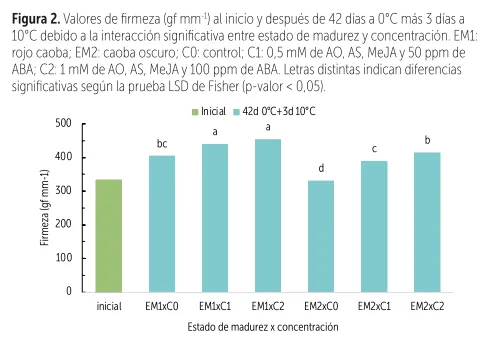 Figure 2. Firmness values (gf mm⁻¹) at the beginning and after 42 days at 0°C plus 3 days at 10°C, due to the significant interaction between maturity stage and concentration. EM1: mahogany red; EM2: dark mahogany; C0: control; C1: 0.5 mM AO, AS, MeJA and 50 ppm ABA; C2: 1 mM AO, AS, MeJA and 100 ppm ABA. Different letters indicate significant differences according to Fisher’s LSD test (p-value < 0.05).
Figure 2. Firmness values (gf mm⁻¹) at the beginning and after 42 days at 0°C plus 3 days at 10°C, due to the significant interaction between maturity stage and concentration. EM1: mahogany red; EM2: dark mahogany; C0: control; C1: 0.5 mM AO, AS, MeJA and 50 ppm ABA; C2: 1 mM AO, AS, MeJA and 100 ppm ABA. Different letters indicate significant differences according to Fisher’s LSD test (p-value < 0.05).
 Figure 3. Firmness values (gf mm⁻¹) of Regina cherries at the beginning and after 42 days at 0°C plus 3 days at 10°C, due to the significant interaction between elicitors and concentration. AO: oxalic acid; AS: salicylic acid; MeJA: methyl jasmonate; ABA: abscisic acid. C1: 0.5 mM AO, AS, MeJA and 50 ppm ABA; C2: 1 mM AO, AS, MeJA and 100 ppm ABA. Different letters indicate significant differences according to Fisher’s LSD test (p-value < 0.05).
Figure 3. Firmness values (gf mm⁻¹) of Regina cherries at the beginning and after 42 days at 0°C plus 3 days at 10°C, due to the significant interaction between elicitors and concentration. AO: oxalic acid; AS: salicylic acid; MeJA: methyl jasmonate; ABA: abscisic acid. C1: 0.5 mM AO, AS, MeJA and 50 ppm ABA; C2: 1 mM AO, AS, MeJA and 100 ppm ABA. Different letters indicate significant differences according to Fisher’s LSD test (p-value < 0.05).
FIRMNESS
Baxlo
After 35 days at 0°C + 3 days at 10°C, firmness ranged between 87° and 94° Ush, with significant interactions between concentration (C) and maturity stage (EM), and between concentration and elicitor (E). Control fruits showed the highest firmness (94° Ush), while the softest were dark mahogany fruits (EM2) treated with concentration 2 (C2), ABA at 50/100 ppm and MeJA at 0.5 mM, with an average of 87° Ush and no significant differences among them.
After 42 days at 0°C + 3 days at 10°C, firmness decreased, ranging from 80° to 84° Ush. In the EM x C interaction, mahogany red fruits treated with C1 showed the highest value (84° Ush), while dark mahogany fruits (regardless of concentration) showed the lowest firmness (80° Ush).
In the E x C interaction, fruits treated with 0.5 and 1 mM AS, 0.5 mM AO, and 0.5 mM MeJA showed the best firmness performance.
FirmPro
After 35 days at 0°C + 3 days at 10°C, significant differences emerged based on maturity stage: mahogany red fruits reached 413 gf mm⁻¹, while dark mahogany fruits reached 379 gf mm⁻¹ (Figure 1).
After 42 days + 3 days, there was an interaction between EM x C and E x C:
The firmest fruits were mahogany red treated with C1 and C2 (average: 448 gf mm⁻¹).
The softest were dark mahogany control fruits (332 gf mm⁻¹; Figure 2).
In the E x C interaction, fruits treated with 1 mM MeJA showed the highest value (496 gf mm⁻¹),
while the softest were those treated with 50 ppm ABA and the controls (average: 379 gf mm⁻¹; Figure 3).
INTERNAL BROWNING (IB)
After 35 days at 0°C + 3 days at 10°C:
74% of the fruits showed IB < 20%,
16% had IB between 20–50%,
10% had IB > 50%.
IB < 20%
Significant interaction between elicitor and concentration:
ABA (50 and 100 ppm) and AS at 1 mM gave the best results (90% of fruits with IB < 20%).
Only 52% of control fruits fell within this level (Figure 4).
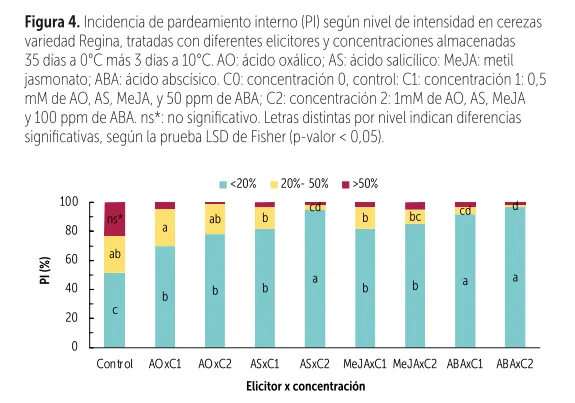 Figure 4. Incidence of internal browning (IB) by intensity level in Regina cherries, treated with different elicitors and concentrations, stored for 35 days at 0°C plus 3 days at 10°C. AO: oxalic acid; AS: salicylic acid; MeJA: methyl jasmonate; ABA: abscisic acid. C0: concentration 0, control; C1: concentration 1: 0.5 mM AO, AS, MeJA and 50 ppm ABA; C2: concentration 2: 1 mM AO, AS, MeJA and 100 ppm ABA. ns*: not significant. Different letters per intensity level indicate significant differences according to Fisher’s LSD test (p-value < 0.05).
Figure 4. Incidence of internal browning (IB) by intensity level in Regina cherries, treated with different elicitors and concentrations, stored for 35 days at 0°C plus 3 days at 10°C. AO: oxalic acid; AS: salicylic acid; MeJA: methyl jasmonate; ABA: abscisic acid. C0: concentration 0, control; C1: concentration 1: 0.5 mM AO, AS, MeJA and 50 ppm ABA; C2: concentration 2: 1 mM AO, AS, MeJA and 100 ppm ABA. ns*: not significant. Different letters per intensity level indicate significant differences according to Fisher’s LSD test (p-value < 0.05).
20% < IB < 50%
Another E x C interaction:
20–25% of control and AO-treated fruits (0.5–1 mM) fell within this range.
EM2 control had the highest value (30%), while EM2 with C2 only 7%.
PI > 50%
No interaction between factors, but concentration had an effect:
23% of control fruit showed severe PI,
while fruit treated with C1 and C2 did not exceed 4% (Figure 5).
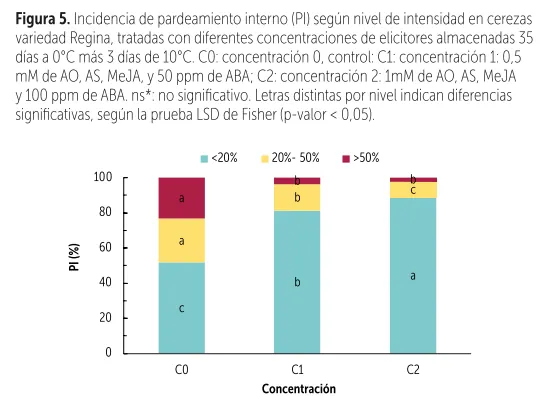 Figure 5. Incidence of internal browning (PI) by intensity level in Regina cherries treated with different elicitor concentrations and stored for 35 days at 0°C plus 3 days at 10°C. C0: concentration 0, control; C1: concentration 1: 0.5 mM AO, AS, MeJA and 50 ppm ABA; C2: concentration 2: 1 mM AO, AS, MeJA and 100 ppm ABA. ns*: not significant. Different letters by level indicate significant differences according to Fisher’s LSD test (p-value < 0.05).
Figure 5. Incidence of internal browning (PI) by intensity level in Regina cherries treated with different elicitor concentrations and stored for 35 days at 0°C plus 3 days at 10°C. C0: concentration 0, control; C1: concentration 1: 0.5 mM AO, AS, MeJA and 50 ppm ABA; C2: concentration 2: 1 mM AO, AS, MeJA and 100 ppm ABA. ns*: not significant. Different letters by level indicate significant differences according to Fisher’s LSD test (p-value < 0.05).
After 42 days at 0°C + 3 days at 10°C:
59% of fruit showed PI < 20%,
24% PI between 20–50%,
17% PI > 50%.
PI < 20%
Interaction between MS and C:
Fruit treated with C2 showed the lowest incidence of PI.
Only 20% of control rojo caoba fruit fell within this range (Figure 6).
Independent effect of the elicitor:
ABA and MeJA: over 60% of fruit with PI < 20%,
approximately 10% more than AO and AS (Figure 7).
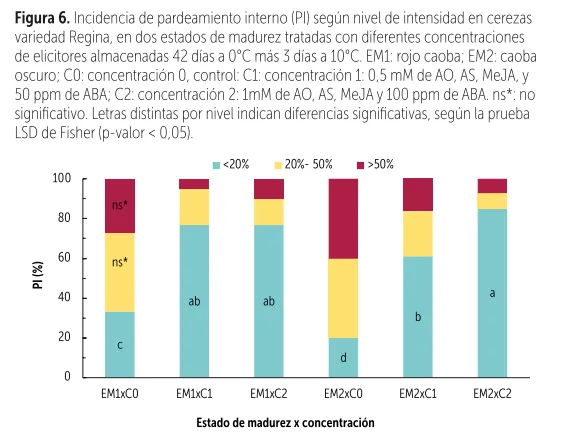 Figure 6. Incidence of internal browning (PI) by intensity level in Regina cherries at two maturity stages treated with different elicitor concentrations, stored for 42 days at 0°C plus 3 days at 10°C. MS1: rojo caoba; MS2: dark caoba; C0: concentration 0, control; C1: concentration 1: 0.5 mM AO, AS, MeJA and 50 ppm ABA; C2: concentration 2: 1 mM AO, AS, MeJA and 100 ppm ABA. ns*: not significant. Different letters by level indicate significant differences according to Fisher’s LSD test (p-value < 0.05).
Figure 6. Incidence of internal browning (PI) by intensity level in Regina cherries at two maturity stages treated with different elicitor concentrations, stored for 42 days at 0°C plus 3 days at 10°C. MS1: rojo caoba; MS2: dark caoba; C0: concentration 0, control; C1: concentration 1: 0.5 mM AO, AS, MeJA and 50 ppm ABA; C2: concentration 2: 1 mM AO, AS, MeJA and 100 ppm ABA. ns*: not significant. Different letters by level indicate significant differences according to Fisher’s LSD test (p-value < 0.05).
 Figure 7. Incidence of internal browning (PI) by intensity level in Regina cherries treated with different elicitors and stored for 42 days at 0°C plus 3 days at 10°C. AO: oxalic acid; AS: salicylic acid; MeJA: methyl jasmonate; ABA: abscisic acid. ns*: not significant. Different letters indicate significant differences according to Fisher’s LSD test (p-value < 0.05).
Figure 7. Incidence of internal browning (PI) by intensity level in Regina cherries treated with different elicitors and stored for 42 days at 0°C plus 3 days at 10°C. AO: oxalic acid; AS: salicylic acid; MeJA: methyl jasmonate; ABA: abscisic acid. ns*: not significant. Different letters indicate significant differences according to Fisher’s LSD test (p-value < 0.05).
20% < PI < 50%
Interaction E x C:
Highest values (30–40%) were recorded for control fruit, AO (0.5–1 mM), and AS (0.5 mM).
Lowest values (3–8%) were observed with AS (1 mM), MeJA (1 mM), and ABA (100 ppm).
PI > 50%
No significant interaction, but differences based on concentration:
33% in control fruit,
<10% in fruit treated with C1 and C2 (Figure 8).
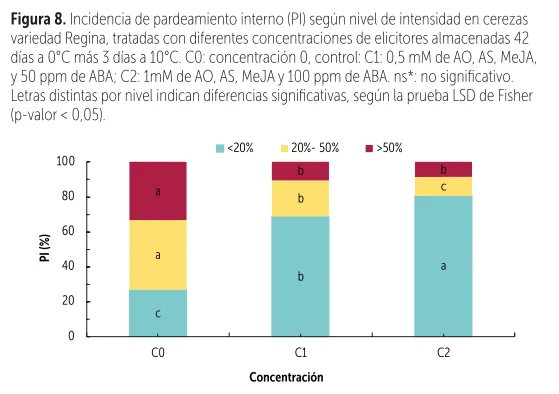 Figure 8. Incidence of internal browning (PI) by intensity level in Regina cherries treated with different elicitor concentrations and stored for 42 days at 0°C plus 3 days at 10°C. C0: concentration 0, control; C1: 0.5 mM AO, AS, MeJA and 50 ppm ABA; C2: 1 mM AO, AS, MeJA and 100 ppm ABA. ns*: not significant. Different letters by level indicate significant differences according to Fisher’s LSD test (p-value < 0.05).
Figure 8. Incidence of internal browning (PI) by intensity level in Regina cherries treated with different elicitor concentrations and stored for 42 days at 0°C plus 3 days at 10°C. C0: concentration 0, control; C1: 0.5 mM AO, AS, MeJA and 50 ppm ABA; C2: 1 mM AO, AS, MeJA and 100 ppm ABA. ns*: not significant. Different letters by level indicate significant differences according to Fisher’s LSD test (p-value < 0.05).
Total Soluble Solids (TSS)
After 35 days at 0°C plus a simulated marketing period, a slight increase in TSS was observed, along with significant differences for both elicitor and concentration factors, considered separately. Fruit treated with oxalic acid (AO) reached a value of 19.8%, higher than those treated with salicylic acid (AS) (Figure 9).
 Figure 9. Total soluble solids (TSS) in Regina cherries treated with different elicitors and stored for 35 and 42 days plus 3 days at 10°C. AO: oxalic acid; AS: salicylic acid; MeJA: methyl jasmonate; ABA: abscisic acid. ns*: not significant. Different letters indicate significant differences according to Fisher’s LSD test (p-value < 0.05).
Figure 9. Total soluble solids (TSS) in Regina cherries treated with different elicitors and stored for 35 and 42 days plus 3 days at 10°C. AO: oxalic acid; AS: salicylic acid; MeJA: methyl jasmonate; ABA: abscisic acid. ns*: not significant. Different letters indicate significant differences according to Fisher’s LSD test (p-value < 0.05).
Control fruit showed a TSS concentration 7% higher than those treated with concentration 1 and 2. After 42 days of storage plus marketing, a significant difference was confirmed for the concentration factor: control fruit recorded the highest value (20.7%), while those treated with C1 and C2 reached 19.4% (Figure 10).
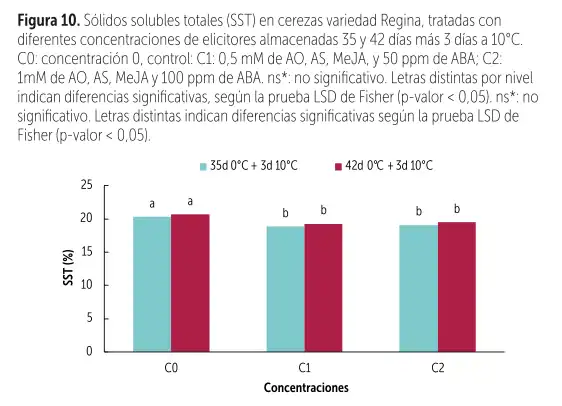 Figure 10. Total soluble solids (TSS) in Regina cherries treated with different elicitor concentrations and stored for 35 and 42 days plus 3 days at 10°C. C0: concentration 0, control; C1: 0.5 mM AO, AS, MeJA and 50 ppm ABA; C2: 1 mM AO, AS, MeJA and 100 ppm ABA. ns*: not significant. Different letters by level indicate significant differences according to Fisher’s LSD test (p-value < 0.05).
Figure 10. Total soluble solids (TSS) in Regina cherries treated with different elicitor concentrations and stored for 35 and 42 days plus 3 days at 10°C. C0: concentration 0, control; C1: 0.5 mM AO, AS, MeJA and 50 ppm ABA; C2: 1 mM AO, AS, MeJA and 100 ppm ABA. ns*: not significant. Different letters by level indicate significant differences according to Fisher’s LSD test (p-value < 0.05).
Acidità titolabile (AT)
Durante il periodo di valutazione, si è osservata una progressiva riduzione dell’acidità nel tempo. Dopo 35 giorni a 0°C più commercializzazione, si è riscontrata un’interazione significativa tra elicitor e concentrazione in entrambi gli stadi di maturazione.
Nei frutti rojo caoba, quelli trattati con 1 mM di AS e 1 mM di ABA hanno mostrato un’acidità del 0,46%, mentre il valore più basso è stato registrato con 1 mM di MeJA (0,34%) (Figura 11).
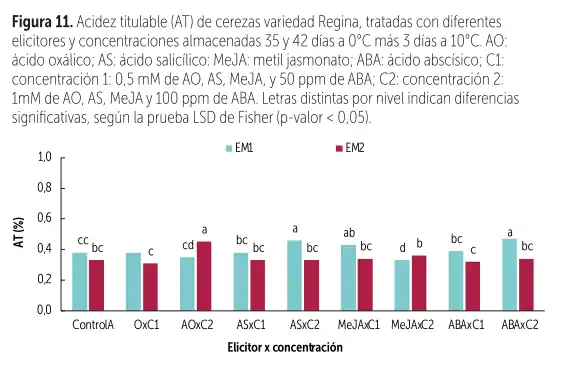 Figura 11. Acidità titolabile (AT) in ciliegie varietà Regina, trattate con diversi elicitori e concentrazioni e conservate per 35 e 42 giorni a 0°C più 3 giorni a 10°C. AO: acido ossalico; AS: acido salicilico; MeJA: metil jasmonato; ABA: acido abscissico; C1: concentrazione 1: 0,5 mM di AO, AS, MeJA e 50 ppm di ABA; C2: concentrazione 2: 1 mM di AO, AS, MeJA e 100 ppm di ABA. Lettere diverse per livello indicano differenze significative, secondo la prova LSD di Fisher (p-valore < 0,05).
Figura 11. Acidità titolabile (AT) in ciliegie varietà Regina, trattate con diversi elicitori e concentrazioni e conservate per 35 e 42 giorni a 0°C più 3 giorni a 10°C. AO: acido ossalico; AS: acido salicilico; MeJA: metil jasmonato; ABA: acido abscissico; C1: concentrazione 1: 0,5 mM di AO, AS, MeJA e 50 ppm di ABA; C2: concentrazione 2: 1 mM di AO, AS, MeJA e 100 ppm di ABA. Lettere diverse per livello indicano differenze significative, secondo la prova LSD di Fisher (p-valore < 0,05).
Nei frutti caoba oscuro, il valore più alto (0,45%) è stato osservato con 1 mM di AO, mentre il più basso è stato ottenuto con 0,5 mM di AO e 50 ppm di ABA (Figura 11).
Dopo 42 giorni + commercializzazione, sono emerse interazioni significative:
- tra stato di maturazione x concentrazione: i frutti rojo caoba trattati con ABA hanno mostrato il valore massimo (0,40%) e i caoba oscuro trattati con AS, MeJA e ABA che hanno registrato il valore più basso (0,30%).
- tra elicitor x concentrazione: i frutti trattati con 100 ppm di ABA hanno mostrato la maggiore acidità, senza differenze rispetto ai frutti di controllo; il valore più basso è stato riscontrato nei frutti trattati con 50 ppm di ABA.
Rapporto SST/AT
Questo rapporto riflette la percezione tra dolcezza e acidità, influenzando il gusto caratteristico delle ciliegie. Un rapporto basso è associato a un gusto più acido, uno alto a una percezione di maggiore dolcezza.
Il rapporto SST/AT è aumentato significativamente nel tempo, soprattutto per la diminuzione dell’acidità.
Dopo 35 giorni + 3 giorni a 10°C:
Nei frutti rojo caoba, si è osservata un’interazione significativa elicitor x concentrazione: i frutti trattati con 1 mM di MeJA hanno raggiunto un valore di 58,5, senza differenze significative rispetto a quelli con 1 mM di AO e ai controlli. I valori più bassi (39,1) sono stati registrati nei frutti trattati con 100 ppm di ABA, 1 mM di AS e 0,5 mM di MeJA (Figura 13).
Nei frutti caoba oscuro, sono emerse differenze significative per il fattore concentrazione, con una diminuzione del rapporto SST/AT all’aumentare della concentrazione, in un intervallo compreso tra 53 e 63.
Dopo 42 giorni + 3 giorni a 10°C:
Interaction between ripening stage × concentration: dark mahogany fruits treated with concentration 1 showed the highest value (70), followed by those treated with concentration 2 (65). Control dark mahogany fruits and all red mahogany fruits (at any concentration) recorded values between 53 and 57, with no significant differences (Figure 14).
Interaction between elicitor × concentration: fruits treated with 50 ppm ABA showed the highest value (69), while control fruits and those treated with 100 ppm ABA had the lowest values (average 53), with no significant differences among them (Figure 12).
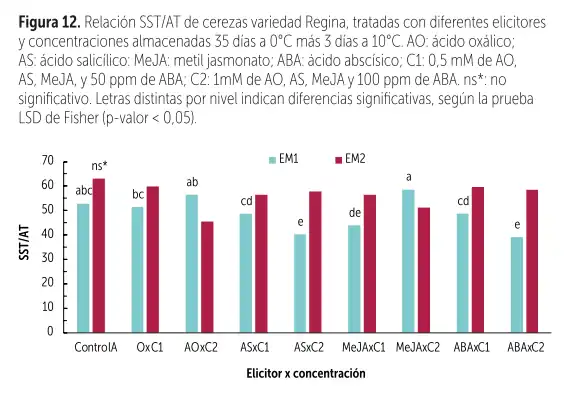 Figure 12. SST/TA ratio in Regina cherries treated with different elicitors and concentrations and stored for 35 days at 0°C plus 3 days at 10°C. AO: oxalic acid; SA: salicylic acid; MeJA: methyl jasmonate; ABA: abscisic acid; C1: 0.5 mM of AO, SA, MeJA and 50 ppm ABA; C2: 1 mM of AO, SA, MeJA and 100 ppm ABA. ns*: not significant. Different letters indicate significant differences according to Fisher's LSD test (p-value < 0.05).
Figure 12. SST/TA ratio in Regina cherries treated with different elicitors and concentrations and stored for 35 days at 0°C plus 3 days at 10°C. AO: oxalic acid; SA: salicylic acid; MeJA: methyl jasmonate; ABA: abscisic acid; C1: 0.5 mM of AO, SA, MeJA and 50 ppm ABA; C2: 1 mM of AO, SA, MeJA and 100 ppm ABA. ns*: not significant. Different letters indicate significant differences according to Fisher's LSD test (p-value < 0.05).
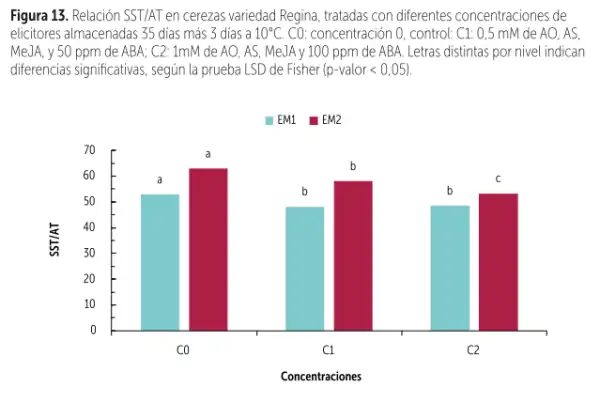 Figure 13. SST/TA ratio in Regina cherries treated with different elicitor concentrations and stored for 35 days plus 3 days at 10°C. C0: concentration 0, control; C1: 0.5 mM of AO, SA, MeJA and 50 ppm ABA; C2: 1 mM of AO, SA, MeJA and 100 ppm ABA. Different letters indicate significant differences according to Fisher's LSD test (p-value < 0.05).
Figure 13. SST/TA ratio in Regina cherries treated with different elicitor concentrations and stored for 35 days plus 3 days at 10°C. C0: concentration 0, control; C1: 0.5 mM of AO, SA, MeJA and 50 ppm ABA; C2: 1 mM of AO, SA, MeJA and 100 ppm ABA. Different letters indicate significant differences according to Fisher's LSD test (p-value < 0.05).
 Figure 14. SST/TA ratio in Regina cherries treated with different elicitors and concentrations and stored for 42 days at 0°C plus 3 days at 10°C. EM1: red mahogany; EM2: dark mahogany; AO: oxalic acid; SA: salicylic acid; MeJA: methyl jasmonate; ABA: abscisic acid; C0: concentration 0, control; C1: 0.5 mM of AO, SA, MeJA and 50 ppm ABA; C2: 1 mM of AO, SA, MeJA and 100 ppm ABA. ns*: not significant. Different letters indicate significant differences according to Fisher's LSD test (p-value < 0.05).
Figure 14. SST/TA ratio in Regina cherries treated with different elicitors and concentrations and stored for 42 days at 0°C plus 3 days at 10°C. EM1: red mahogany; EM2: dark mahogany; AO: oxalic acid; SA: salicylic acid; MeJA: methyl jasmonate; ABA: abscisic acid; C0: concentration 0, control; C1: 0.5 mM of AO, SA, MeJA and 50 ppm ABA; C2: 1 mM of AO, SA, MeJA and 100 ppm ABA. ns*: not significant. Different letters indicate significant differences according to Fisher's LSD test (p-value < 0.05).
Final considerations
Pitting was the main defect observed in the Regina variety, despite its classification as resistant to mechanical damage. Fruits at a more advanced ripening stage (dark mahogany) showed higher incidence of this defect, while red mahogany fruits recorded the highest percentage of defect-free samples.
Red mahogany fruits started storage with greater firmness compared to dark mahogany ones, and this difference persisted throughout the storage period, regardless of treatment. A direct positive relationship was observed between applied concentration and firmness, and an inverse relationship with internal browning. This suggests that elicitor use had a positive effect on maintaining fruit quality over time.
ABA applications, while effectively reducing internal browning for at least 42 days, resulted in lower fruit firmness, likely due to its effect on ripening processes.
SA and MeJA proved effective in reducing internal browning without compromising firmness, while SA and ABA helped maintain acidity and a stable SST/TA ratio over time.
Fernanda Hernandez, Rodrigo Neira, Joaquin Villegas, Matias Pina, Thomas Fichet, Victor H. Escalona
Universidad Politécnica de Cartagena, Universidad de Chile
Source text and images: Redagricola
Cherry Times - All rights reserved





















